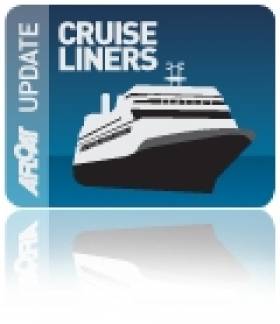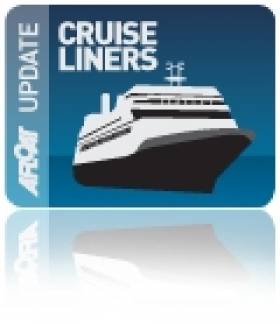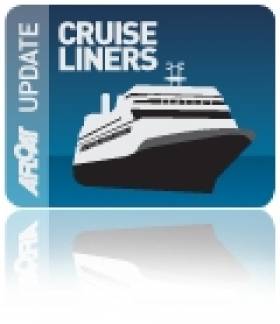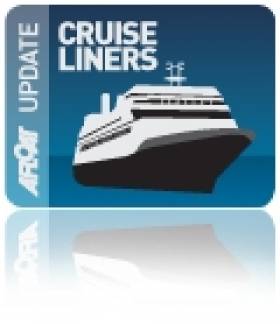Displaying items by tag: Cruise liner
The spectacular 333m MSC Splendida, the longest ship ever to visit Dublin Port, returned to Dublin early this morning officially marking the start of Dublin Port’s 2016 cruise season. She is one of 113 cruise calls confirmed for Dublin Port this year, a record number of cruise calls in a year for Dublin Port that will bring over 180,000 visitors to experience the city’s sights and attractions.
Currently the 11th longest cruise ship in the world, the MSC Splendida arrived in Dublin from Greenock, Scotland carrying over 4,600 passengers and crew on board. Her inaugural call made maritime history when she became the longest vessel ever to visit Dublin Port last summer. She boasts a VIP section with 24 hour butler service and features more than a dozen bars and lounges, a spa and Turkish baths, four swimming pools, squash courts and a Formula 1 simulator, all spread over 18 decks. Having arrived from Greenock, Scotland, the MSC Splendida will depart Dublin at 7:45pm for Cork.
The MSC Splendida and other ships greater than 300m in length cannot turn presently within Dublin Port and therefore are brought stern first (reversed) up the Liffey. However, this complicated manoeuvre will no longer be required once the €230m Alexandra Basin Redevelopment (ABR) Project, which will expand capacity in Dublin Port, is complete. Larger ships will then be able to routinely call at the port and turn within the expanded Alexandra Basin West and berth as far upriver as East Link Bridge.
Pat Ward, Head of Corporate Services, Dublin Port Company, said: “We are delighted to welcome the MSC Splendida, the longest ship ever to visit Dublin Port, back to the city to mark the start of our 2016 cruise season. We are shaping up for a record year in cruise tourism, with some 113 cruise calls carrying over 180,000 visitors to the city scheduled for 2016. Highlights this season include the arrival of “Disney Magic” on her maiden call to Ireland in May, as Dublin Port becomes the first Irish port to welcome Disney Cruise Line. Dublin Port will also host the Cruise Europe Conference this year, the first time the conference is to be held in Dublin.”
First Cruise Liner Arrives into Port of Cork on April 1st
Fred Olsen Cruise Line will open the Port of Cork’s cruise liner season with the arrival of MV Balmoral and her 1800 passengers and crew to Cobh Cruise Terminal on Friday 1st April. This is the first of 58 liners scheduled to call in 2016. In total over 100,000 passengers and crew will arrive in the region between April and December, with some liners calling for the first time to Cobh and others on repeat visits. Princess Cruises’, MV Caribbean Princess will make ten visits to Cobh in 2016.
In 2015 the Port of Cork invested €1.5 million in upgrading the current facilities at Cobh Cruise Terminal, Ireland’s only dedicated cruise berth. The investment included installation of a number of high load mooring bollards at the east and west end of the Cobh Cruise Berth which will enable larger ships to be berthed.
Commercial Manager at the Port of Cork, Captain Michael McCarthy said: “ We are pleased with the number of calls for 2016 and the fact that we have some new customers this year, shows more and more cruise companies are considering Cobh as part of their cruising route.’
He continued: “Following the investment last year, the Port of Cork can now accommodate the larger liners or Quantum class ships without any restrictions. It is our ambition as a port company to attract these ships and increase our cruise calls to 75 per year over the next three years.’
The cruise business in Cork contributes over €4million annually to the local economy, which is a welcome boost for business in Cork City, Cork County, East Cork and West Cork.
In 2016 Bantry Bay Port Company will welcome three cruise liners to the area, one of which, MV Albatross, will call to Bantry followed by Cobh. This shows the connection between the ports and the joined up promotion of both regions to the cruise companies.
#cruiseliner – Next Wednesday (15th July), Britain's biggest cruise ship, P&O Cruises Britannia, will be making a highly anticipated maiden call into Cobh in the Port of Cork as part of her first ever British Isles cruise.
The biggest ship designed exclusively for Britain, Britannia is P&O Cruises' latest "modern classic", heralding a new era of holiday choice. Chief amongst her features are her restaurants, bars and cafes, with menus and culinary experiences created by P&O Cruises' 'Food Heroes'; James Martin, Marco Pierre White, Atul Kochhar, Eric Lanlard, wine expert Olly Smith and cheese expert Charlie Turnbull. In the new Cookery Club, a 24 person state-of-the-art cookery school, these celebrity chefs and experts will demonstrate their culinary skills, and will be joined throughout this year by other famous chefs including Mary Berry CBE, Pierre Koffmann, Paul Rankin and Commendatore Antonio Carluccio OBE.
Britannia's most outstanding design statement is reserved for her three-deck high atrium with illuminating Star Burst sculpture. She also provides the largest British spa at sea, a state-of-the-art theatre with LED wall, four pools, gym and a multi-million pound art collection including a specially commissioned representation of the "Spirit of Modern Britain" from artist Johnny Bull.
P&O Cruises marketing director Christopher Edgington said: "It is fitting that Britannia's maiden season includes a British Isles itinerary featuring calls into so many wonderful ports of call. We are excited to be able to showcase this fabulous ship in Cobh and hope that the residents of Cobh are just as excited to see her. Not only will Britannia provide a boost to the local economy but she will be spectacular addition to the Irish coastline."
Britannia is expected to arrive in Cobh carrying 3,647 passengers and 1,350 crew at 0730hrs on 15th July and will depart at 2300hrs.
#cruiseliner – The master of a cruise liner, which was damaged going over rocky shoals has pleaded guilty to two charges at Belfast Magistrates court today (16th June).
Captain Joao Manuel Fernandes Simoes (58) pleaded guilty to failure to properly passage plan in breach of SOLAS and failure to report the incident contrary to the Merchant Shipping vessel traffic monitoring and reporting requirement regulations.
On 11th May 2015 the Bahamas registered cruise liner mv Hamburg called in to Tobermory enroute from Dublin to Hamburg.
The Bay could not be entered on arrival as there were already two other cruise liners so the Hamburg remained outside about two miles to the North East of the popular port. The call to enter came at around 1pm and a course was set direct to the port.
The track took the ship close to a starboard hand channel buoy, but the approach was from the north of the buoy, not the west, over rocky shoals. The port side grazed along the side of the rocks and the propeller struck causing the ship to temporarily black out. The port engine could no longer be used and the ship limped in to Tobermory Bay. After an internal inspection the ship was instructed by owners to proceed to Belfast.
At around 6pm, the mother of a crew member had spoken to her daughter and been told what had happened. She lost the phone signal and fearing the worst called the Irish coastguard. They in turn called the UK Coastguard, who contacted the ship.
He was fined £400 for each charge and £13 costs – a total of £813.
The judge, his honour K Nickson said he appreciated that other people were on the bridge at the time but the captain was in charge and had to take responsibility.
The Surveyor in Charge of MCA Glasgow, Fraser Heasley said: 'This incident could very nearly have ended in tragedy.
'The master failed in his duty to keep a proper lookout and to ensure the safety of his passengers and crew. Following the grounding he proceeded directly to Belfast without notifying the appropriate authorities or accurately assessing the extent of bottom damage by an underwater dive survey.'
#dlharbour – Hostile questions were asked in the Dail on Wednesday by local TD Richard Boyd Barrett on the proposed development of Dun Laoghaire Harbour as a cruise liner port. They were deflected in ministerial replies about legislation currently being drafted, and the two possible viable ways forward for the harbour's administration. But the underlying pace is accelerating towards a resolution of the future of this unique example of Victorian design, engineering and construction. W M Nixon finds that, in recent days and weeks, his views on the possible uses of this magnificent artificial harbour have undergone considerable change.
Embarrassment is a powerful stimulant for change. Change of attitude, change in ways in behaving, change in ways of looking at things, change to entrenched ways of thinking. I was hugely embarrassed by something seen in Dun Laoghaire nine days ago. And within seconds, there came a complete epiphany, with the sudden awareness that an entrenched attitude towards the development of Dun Laoghaire as a cruise liner port had turned through about 140 degrees.
It made for the complete 180 degrees, as the first 40 degrees of the turn had already been achieved a couple of weeks previously, while spending two completely absorbing if mentally exhausting hours with the maverick Alistair Rumball and his team at the Irish National Sailing School beside the inner recesses of Dun Laoghaire's inner harbour, which is still called the Coal Harbour even though it's very many years since anyone offloaded any lumps of the black gold there.
Be that as it may, as we parted we were shooting the breeze about the proposed development of Dun Laoghaire as a cruise liner port, which has been top of the local agenda since the end of March, and handily gave us one of our choicer April Fool's Day stories here on Afloat.ie - it proved so effective we had to add a health warning.
When a story provides you with something like that, you develop a certain affection for it. So while Alistair and I agreed that that the absolute dream solution for Dun Laoghaire Harbour would be a top-of-the-line government-funded National Monument Preservation Scheme, with the entire place given over exclusively to recreation afloat and ashore, and no commercial shipping of any significant size whatsoever allowed about the place, we knew it was pie in the sky.
"How on earth would they really pay for it?" he asked. "This place is huge, it costs a fortune to run and maintain. A cruise liner berth offers the best and most compact method of providing a worthwhile income stream. And as we in our sailing school – being a commercial operation – have to be rigorous in observing harbour regulations and keeping clear of the established in-harbour shipping lanes, we know that you can continue to sail small boats in large areas of the harbour without any undue sense of space restrictions".
Subsequently, I've been spending some time around Cork Harbour, where circumstances are so different from Dublin Bay that, unlikely as it may seem, you end up feeling sorry for the sailors of south Dublin. For while Cork is almost embarrassed by its riches in natural amenities for sailing, and it's all in a large and attractive harbour where marinas can be put down almost anywhere with no more than a floating breakwater to provide the necessary minimum of shelter, Dublin Bay by contrast is a hugely deprived area in terms of natural waterfront facilities for sailing, yet any attempts to provide man-made shoreline amenities for boats and sailors are dogged with local opposition every inch of the way.

Around Cork Harbour, it only needs a floating breakwater and, hey presto, you've suddenly got a marina - as seen here at Monkstown. Photo: W M Nixon
Thoughts of this struggle, and how things change, emerged again for various reasons in Dun Laoghaire nine days ago, at the reception in Irish Lights HQ to launch the Great Lighthouses Tourism Initiative. Time was when our many fine lighthouses were places of mystery, and permission to visit took quite a bit of arranging if it could be managed at all. But my word, times have changed. In this electronic age, there are those who wonder if we need all our lighthouses. Yet Irish Lights is legally obliged to maintain them, and the built structures around them.
So Yvonne Shields, the CEO of Irish Lights, whom we'd describe as very switched on and extremely bright were we not talking of the top executive in a lights organisation, unveiled this sensible scheme whereby twelve of our greatest lighthouses are being transformed into stations on a tourist trail, while continuing as working lighthouses.
As the greatest and most monumental lighthouses on land tend to be on rugged headlands in remote areas, in the eyes of Brussels they're in peripheral areas deserving special aid. So there's €2 million of Eurodosh going into this project, which sees what had become increasing liabilities being transformed into tourist resources. And if we're going to be sniffy about that, let's face it: the kind of tourist who'll want to visit a remote lighthouse will not be the kind of tourist who would keep you well clear of Temple Bar.
So the old grey matter was churning briskly away on the business of seeing lighthouses in a new way as we headed home past the Coal Harbour, and there it was: The Embarrassment. For this was the evening at the end of the day when the majestic and rather handsome cruise liner Queen Mary 2 was anchored off Dun Laoghaire in a near gale from the southwest which had delayed the morning's arrangements to ferry passengers ashore in the ship's own tenders to the special landing pontoon installed by the Harbour Company in the inner harbour.
By this time, they were trying to return on board, waiting patiently in a queue which ran the length of the inner pier and more as the two ship's tenders bustled the mile and a half plus out to the ship, yet still more buses turned up to disgorge more passengers, such that for a while the long length of the queue seemed to stay persistently the same.
Perhaps it's because we Irish don't do queuing that I found the entire thing acutely embarrassing to behold. And it wasn't even as if it was raining, which it well could have been. Nevertheless it struck me as being a Third World sort of scenario. Yet obviously these people were keen to visit Dun Laoghaire – most of the thousands of passengers on board had elected to go ashore.

This just won't do at all – images of Third World destinations came to mind on seeing the passengers from the Queen Mary 3 queuing in the Coal Harbour in Dun Laoghaire to get back out to their ship anchored in the bay. Photo: W M Nixon
So the epiphany came with the essential flashing great light. If we're going to have cruise liners calling at Dun Laoghaire, boomed this disembodied voice, then let's do it properly and provide them with a proper berth. Otherwise, don't have them about the place at all. But please, please – no more buzzing in and out in little tenders in this Irish climate, and no more queuing on a comfortless pier. It's an affront to our best traditions of hospitality.
This sudden firing-up with all the zeal of the recent convert (for until then, I'd wanted Dun Laoghaire to stay exactly as it is, and damn the expense) resulted in my being right into the dragon's den four days later. It was meant to be a short and businesslike meeting with Gerry Dunne, the CEO of Dun Laoghaire Harbour Company, to discuss the Cruise Liner Berth Proposals. But so many ideas were flying around that we ran well over time.
Please be assured, though, that I did my best to represent the needs of the boat-owning and sailing community while accepting that since Stena Sealink withdrew from running a ferry service from Dun Laoghaire to Holyhead, something very serious indeed needs to be done to pay for the maintenance of the harbour.
We have to remember that, among Ireland's main sailing centres, Cork and Kinsale are blessed with such good natural harbours that any marinas located in either harbour do not need fixed breakwaters. As for Bangor Marina on Belfast Lough, it may need a very substantial solid breakwater on its north side, but otherwise - thanks to being located in a bay - three of its four sides are naturally sheltered. But Dun Laoghaire is badly done by – it's so totally an artificial harbour in an exposed location that three of its four sides are protected by large man-made breakwaters, and while they are constructed in monumental style, continuous monitoring and maintenance is essential.
This is costly, but it would become even more so were standards allowed to slip for even a year or two. Even with the present high standards, there can be underlying wear and tear which in time needs major capital expenditure, and according to one recent report, hidden erosion on the most exposed section of the East Pier may eventually need up to €5 million for a proper remedial job.
As it is, the current basic running costs of the harbour are between €2 and €2.5 million a year. Were it kept as a purely recreational harbour and general public amenity, this figure could perhaps be slightly reduced. Yet the Dun Laoghaire recreational boating market still could not withstand paying the full amount out of its own resources and expected annual expenditure, so the shortfall would have to be made up by Government subvention.
But would the sailing and boating people of Dun Laoghaire really like to feel that they're beholden to taxpayers throughout Ireland for their continuing enjoyment of this wonderful amenity at affordable prices? There's something unpleasantly artificial about the idea of such an arrangement, whereas a harbour which is providing a modest but genuine profit is something which has a much healthier feel to it.
Surely if a way can be found of generating a worthwhile income stream without unduly distorting the traditional functioning of the harbour, then that idea should at the very least be actively explored, and recreational boating groups should be prepared to reach out towards compromises in the knowledge that, in turn, such arrangements would make the Harbour Company more accountable to all.
However, local representative Richard Boyd Barrett TD of the People Before Profit party, and Chair of Dun Laoghaire Save Our Seafront Group, sees it differently, and he has called for "a major campaign of people power against the planned cruise berth, and to protect the future of the harbour as a public amenity". His three main objections to a cruise berth plan are "(1) That the cost and financing of the project at €18 million means that the Harbour Company will have to borrow using its existing assets, where no proper business case has been produced. This puts the very future of the harbour at risk. (2) The entire plan has been hatched by an unelected board of the Harbour Company, Council Executives, and local business people who ran a sham of a public consultation over the two weeks of the Easter Holidays, and (3) The scale of the luxury liners at 300 metres long and 59 metres high will dwarf the harbour and reduce public access and public enjoyment of the most intact Victorian harbour in Britain and Ireland".
So with a Harbour Company which is government-owned, yet is charged with maximizing the economic benefit and exploiting the commercial opportunities provided by Dun Laoghaire Harbour, clearly there is something of a divide between the two sides. In fact, "light years apart" just about sums it up.
Nevertheless, politics being the art of the possible, it has to be possible to bring people together sufficiently to see that perhaps a proper sympathetically-designed cruise liner berth might indeed be the answer. After all, although it was built between 1817 and 1842 purely as a harbour of refuge for sailing ships with no thought of any interaction between sea and land, it very quickly became a ferry port for cross-channel steamships. At the height of this activity, with frequent roll-on roll-off ferries and their unpleasant shoreside traffic dominating the waterfront, Dun Laoghaire had lost much of its charm.
For the life of me I can't see that the much more limited shoreside traffic generated by the visits of cruise liners in the summer months can be seen as being anything like as obnoxious as the previous waves of road and rail traffic for the ferries, which was readily tolerated, and helped to keep the place going for 180 years.
And in any case, with the end of the ferry services, Dun Laoghaire definitely lacks purpose. In the Irish climate, it is very difficult to maintain a sense of vitality around a harbour which is purely devoted to personal recreation, whether afloat and ashore. It could be argued that, regardless of the economic benefits, it would be good for the mental spirit and communal well-being of Dun Laoghaire to be a cruise liner port of call, as a cruise liner strikes a neat balance between work and play. Like it or not, all work and no play may make Jack a dull boy, but all play and no work makes him mad.
But even if we accept that the shoreside traffic will be much less than it was with the regular ferries even if there is a cruise liner in port every other day, that is only part of the equation. How does the town itself shape up as a desirable cruise liner destination?
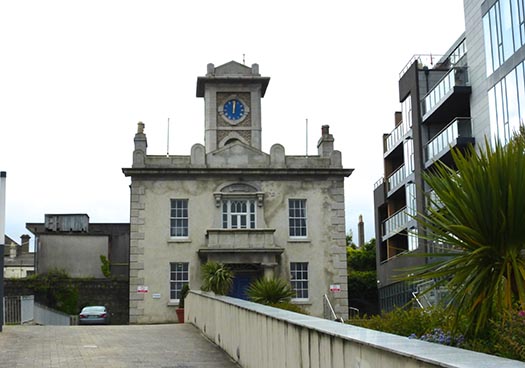
The Harbour Lodge is symbolic of today's Dun Laoghaire, a classical building from an earlier age, but now enclosed by modernity. Photo: W M Nixon
When we get down to the nitty gritty like this, Gerry Dunne is in his element. He's an affable guy, and good company, but I wouldn't like to get into a row with him, as there's steel underneath it all. So in the sedate setting of Harbour Lodge – which he cheerfully admits his opponents and friends have nick-named "Mussolini's Palace" – he's just the man to fight off the brickbats and work his way towards several objectives. But although he actually lives in Dun Laoghaire within walking distance of his office, he's not really into boat and water sports, yet that's no drawback, as personal preferences definitely don't come into it at all as he plans the way ahead.
He makes no bones about admitting that his attitude is strongly commercial. Before taking over the reins at Dun Laoghaire Harbour Company, he was Commercial Director at RTE, a job description which boggles the mind. Before that, he honed his skills in the UK, working for several large Irish food companies. If that gives you a vision of ditzy little artisan cheeses selling in agreeable country shops, then perish the thought – the big Irish food industries provide as tough a business environment as you could imagine.

The many moods of Gerry Dunne.Toughened by a varied and demanding career in business and marketing, he has brought a fresh mind to the problems of making Dun Laoghaire harbour economically viable. Photos: W M Nixon
He joined the Harbour Company in 2009, when talk of Stena's withdrawal was already in the wind. So he got Dun Laoghaire moving towards the cruise liner market in a small way, with the miniature 53-passenger Quest in 2011. Finding Quest an in-harbour berth was no problem, and she provided invaluable information on what Dun Laoghaire can provide as a USP for discerning cruise liner passengers. For Quest's rather specialist group, it was the easy access to the Wicklow Hills and particularly Mount Ussher Gardens, and they definitely didn't want to have to travel through Dublin City to get there.

The mini liner Quest – seen here in the Arctic - began the programme of attracting cruise ships to Dun Laoghaire in 2011
So far so good, but Gerry Dunne really struck gold when he started going to the cruise liner fairs in America and Europe. Gradually he built up a useful network, and again he struck gold when he got a report on the potential attractions of Dun Laoghaire from the Vice President (Itineraries) of one of the biggest American cruise liner conglomerates. Asked to sum up in one word the attraction of the Dun Laoghaire for visitors coming in from sea, her answer was: "Serenity".
We've become accustomed to Venice being talked of as The Most Serene Republic - The Serenissima. But it makes you sit up and take notice to hear of Dun Laoghaire being so described by a tough American businesswoman. Yet that's the impression the waterfront area, with its combination of the old yacht clubs, the station, the Town Hall and the Royal Marine Hotel, apparently makes on seaborn visitors from cruise liners, even if their liners are at present anchored outside the harbour and they have to be ferried in to land by ship's tenders. It seems they can blank out the less attractive buildings, and are left with the abiding impression of relaxed elegance with an easygoing way of life.
This takes a bit of getting used to, as it's so much at variance with the perception in Ireland of Dun Laoghaire as a place where they'd argue over anything and everything all the time, while just up the street there's the real problem of the dreary array of boarded-up shops. But like it or lump it, here it is folks – the reality is the yacht clubs and other other historically significant and stylish buildings of the Dun Laoghaire waterfront area – including the pleasantly under-stated Victorian residential terraces - are the town's greatest tourist asset.
Quite what some of the more senior members of the yacht clubs will make of that we can only guess, but the word is that the clubs have indicated that they'll be prepared to welcome some cruiser liner guests to their premises at pre-arranged times. So perhaps we should see the cruise liners as no more than extra-super super yachts......And there's no doubt that many rugged sailing folk from Dun Laoghaire are themselves only too happy to tootle off on a cruise liner when the peak of the sailing season is over.
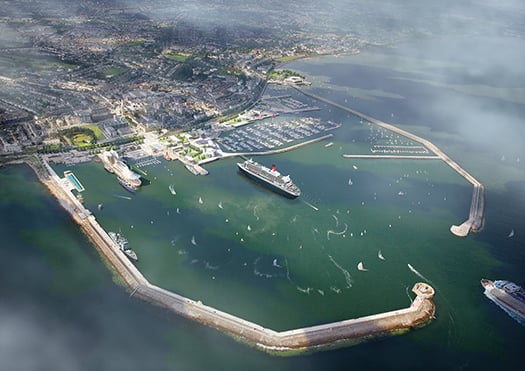
The artist's impression was just that – an artist's impression. If the new berth goes ahead, cruise liners will actually have their sterns towards the town.
But what is the reality if the new berth is agreed? Well, you can forget about your artist's impressions showing a liner facing the town. Space will be restricted, so the liners will come in stern first, thereby enabling them to make an elegant departure for the benefit of crowds down the end of the piers, which could become a popular occurrence.
The new liner pier will be as short as possible, though it will have an underpass for small craft, while the bows of the ships themselves will be held in place by dolphins, as was the HSS ferry. If you think that getting into this berth will involve impossibly ticklish manoeuvring, consider this recent photo of the three Cunard Queens up close and friendly in Southampton, and note that there's no lack of small craft nipping about among them.
 The three Cunarders can manoeuvre unaided at close quarters even with several small craft nipping about their heels, as seen here in Southampton
The three Cunarders can manoeuvre unaided at close quarters even with several small craft nipping about their heels, as seen here in Southampton
One of the other drawbacks about the current setup, with the ships anchoring off and people disembarking in the Coal Harbour, is that there's very little space for buses to move about, but the present waterfront marshalling yard left behind by the exit of Sealink will greatly relieve that problem if the new berth is built. At the moment, it is planned that passengers will walk the short length of the pier to reach their buses, but my own feeling is that the pier should be made a bit wider with a turning circle in order that passengers may board their buses almost directly from the ship, for we're not talking long distance athletes here.
That said, those who are fitter can come and go as they please, with the town within easy reach, whereas being anchored off can cause cabin fever. In other words, if Dun Laoghaire is going to have a cruise liner berth, let it be done properly – half measures involving long walks to buses just won't do, but equally for those who do walk, the town must feel accessible and welcoming.
As to the amount of space the ship will take up in the harbour, that will vary from ship to ship, but some are indeed enormous. And their wind-deflecting presence will certainly add an extra interest to in-harbour dinghy racing. As for the interest of the in-harbour racing for the visitors on the ship, that in turn will all be part of Dun Laoghaire's colourful charm, for which their ship will provide a grandstand view.
In line with that, we should remember that the leading in-harbour class, the historic Water Wags, have only just returned from showing themselves off at Morbihan Sailing week in France. Thus they'll scarcely be unduly bothered about providing a source of fascination for passengers on cruise liners, some of whom will probably be former dinghy racers themselves.

The Water Wags find it easy to sail freely within Dun Laoghaire Marina on their way out to race in the main harbour, so their only problem with a cruise liner berthed in mid-harbour will be the effect it has on wind flow. Photo: W M Nixon
But what the in-harbour dinghy racers are already becoming happily accustomed to is the newly-emptied eastern half of the harbour, with space now provided where boats used to moor. And this area will not be at risk from maneuvering cruise liners – there's not the depth for them. Finally, as to the height or otherwise of the ships in relation to other structures in Dun Laoghaire, I think we've been righteously indignant about this on a mistaken premise – since the new library was pushed into place, all bets about skyline heights and an elegant relationship with other waterfront buildings are clearly off.
So if the sailing and boating community can be more accepting of the cruise liners which will ultimately provide a real source of income to maintain the harbour which makes their activities possible, what can they expect in return?
They're in a strong negotiating position. After all, the Harbour Company's research has shown it is the comfortable presence of the yacht clubs which underpins this vision of serenity which is Dun Laoghaire's most appealing attraction for the kind of people who enjoy the cruise liner experience. So it's very much in the Harbour Company's interest to keep the clubs in good health.
By today's standards, the Royal Irish YC is thriving, thanks in no small part to its location within the marina against whose creation, ironically, the club fought tooth and nail. But the other three clubs – the Royal St George, the National, and the Dun Laoghaire MYC – are blighted by the limited and relatively unsheltered pontoon berthing at their clubhouses.
It may well be – and I'm only guessing – that the Marina Company's agreement with the Harbour Company includes a clause that these three clubs are not allowed to have their own adjacent marinas. But if such a clause exists, then it should be deleted for the greater good of the harbour and the vitality of the waterfront in general, and the three clubs should be facilitated in providing 150-boat marinas – with proper breakwaters for the George and National - in front of each clubhouse.

Dun Laoghaire from the southeast. If the new cruise liner berth is installed at mid-harbour, a longterm plan could be the installation of breakwaters in front of the Royal St George YC and the National YC in the foreground to shelter two new 150-boat marinas, as the location of the Royal Irish YC within the main marina gives it an unfair advantage in providing facilities for its members.
As to how Dun Laoghaire town can benefit, that's another matter altogether. The much stronger income and improved employment going through the Harbour Company will undoubtedly be a tangible good, though how seasonal it will be – with liners expected only between April and October – remains to be seen.
But personal expenditure by cruise liner passengers in the town is an imponderable. In fact, some cruise liners in the popular sunshine destinations are notorious for disembarking guests who feel that they made their total investment with the purchase of the ticket back home, so they don't plan to spend any more.
The historic little Venetian city-port of Dubrovnik on the Adriatic – which doesn't have a proper liner port – recently banned cruise liners from coming anywhere near the place, as their thousands of passengers made the narrow streets very uncomfortably crammed at peak times, yet the average expenditure ashore in Dubrovnik by each cruise liner passenger was precisely €6. There's food for thought. But we will of course get a better class of cruise liner passenger in Dun Laoghaire...
#queenmary2 – 'What is the name of the big, blue ship off Dun Laoghaire?' might well be a common Google search next Wednesday, May 20th when the Queen Mary II anchors off Scotsman's Bay at 7am. Interest in cruise liners was at a high this week for the start of the Cruise Ship season into Ireland when Royal Princess Cruise Liner passengers were welcomed at Dun Laoghaire on Tuesday and equally on Monday when the longest ever ship, the MSC Splendida cruise liner docked in Dublin Port.
RMS Queen Mary 2, the world's largest ocean liner made her maiden visit to Dublin Bay a year ago and returns almost a year to the day into Scotsman's Bay next Wednesday.
Another five star welcome is in store for some 3,000 passengers who will be greeted by a piper and Irish dancers, tour guides, free wireless and business offers after docking at the Coal Harbour.
The RMS Queen Mary II is the second of a flotilla of more than 20 floating visitors to Dún Laoghaire this year, bringing over 100,000 cruise passengers. This compares with just 200 passengers arriving in the harbour in 2012.
RMS Queen Mary II departs Dun Laoghaire just before low tide at 6pm next Wednesday.
#inss – Last week, Sailing on Saturday featured the Royal Cork Yacht Club, the oldest in the world, as it comfortably donned the mantle of the ISA/Mitsubishi Motors Sailing Club of the Year 2015. This morning, we find ourselves involved with what may well be the newest sailing club in the world, the Irish National Sailing Club. It is certainly, thanks to being inaugurated nearly three months after Youghal SC was founded on 28th October 2014, the newest in Ireland. W M Nixon tries to explain it all as he finds himself in the world of Irish sailing's most complete dynamo.
Alistair Rumball is a Life Member of the Awkward Squad. Cage-rattling and pot-stirring are second nature to him. But it's not because of experiencing an unhappy childhood. On the contrary, while growing up in Malahide, his boyhood summers were bliss. He and his brother Arthur had as much sailing as they could want, fitted in between part-time jobs raising pocket-money with a morning picking potatoes at Dermot Dickie's farm along the Broadmeadow Estuary, followed by an afternoon of sailing the sea with the sun always shining, and then maybe an evening of club racing followed by the easy camaraderie among kids who are comfortable with boats.
It was an idyllic maritime environment which, over the years, has produced some of Ireland's top racing and cruising sailors. But while the young Rumball was no slouch on the race-course, the strongest feeling he had about sailing was the sheer fun of it all, the totally absorbing wonder of being in a boat and hauling on ropes to make sails change shape and help you along your chosen course over the always interesting sea.
Although he graduated from Trinity College Dublin as an engineer, he increasingly had this almost evangelical attitude to spreading the good news about the fun of sailing. And while he has something of a reputation – to say the least - for being confrontational, it's central to his contradictory character that he's an extremely good teacher. If somebody shows the slightest genuine enthusiasm about wanting to learn to sail, Alistair Rumball has been prepared to go to endless lengths to teach him or her to do so, and to do so with enjoyment.
Underlying that, we find the first of his gripes about the modern sailing scene. He reckons that it has become far too serious. Don't think for a moment, though, that he believes in a frivolous approach to boats and sailing. He's deadly serious about having everything just right as regards safety and function.
But once that's sorted, then he firmly believes that you should go out and enjoy it. He waxes lyrical about moments of sheer sailing ecstasy he has enjoyed in a wide variety of boats in many sailing locations worldwide. And whatever he may have formally set out to be in a professional career, his working life has been spent in and around boats, getting people introduced to boats and out afloat, sometimes on an almost industrial scale.
Time was when sailing skills were something you acquired by a sort of osmosis through family tradition, club opportunities, and friendship examples. That's mostly how Rumball himself learned to handle a sailing boat. But he seems to have this almost messianic zeal to teach people to sail, and he became convinced that the future lay in more structured training with a proper syllabus.
Having taken a long hard look at the population distribution of the Greater Dublin area and where they might best get afloat in worthwhile numbers, in 1978 he acquired the assets of a moribund organisation, the Dun Laoghaire Sailing School, and soon found himself giving his first lessons to two pupils using a fibreglass-clinker Darragh 14 knockabout sailing dinghy which they'd launched from the public slipway in the Coal Harbour in Dun Laoghaire. The long journey had started towards an organisation whose activities today today include top-of-the-line race training in 1720s in winning mode:
The majestic granite harbour of Dun Laoghaire was a cold place in 1978 for any young enthusiasts trying to set up an independent sailing school on a commercial basis. For the powers that be, sailing was something to be learned through family and clubs under the Junior Training Programme of the Irish Yachting Association. If you were a young person or adult from a non-sailing background but keen to learn, unless you'd an obliging and patient friend from within the sailing establishment, the expectation was that you'd take yourself off to somewhere far away like the Glenans Ireland bases in Baltimore and Bere Island and Clew Bay, and eventually reappear after a decent interval with enough experience, newfound ability and contacts to make the grade in the Dublin Bay sailing scene, where the very thought of a raw in-harbour sailing school for outsiders seemed distasteful to the establishment.
Yet hidden away in the southwest corner of Dun Laoghaire harbour, here was this gadfly of the sailing scene, Can–do Alistair with his rough and ready sailing school enthusiastically recruiting pupils anywhere and everywhere, and taking them afloat in boats which may not have been in the most pristine condition, and certainly set sails which would not be winners on the race course, yet they were safe and able, and so were he and his instructors.
Over the years, an entire cohort of people, mainly from Dublin but also from all over Ireland with a useful smattering of pupils from abroad, came to boats and sailing thanks to this wild-haired character whose love of his demanding work shone through everything he did.
Gradually the fleet expanded, and so too did the "Rumball Group's" activities, even though the very limited availability of premises on the Dun Laoghaire waterfront meant that every little square foot they had always seemed to serve at least three different purposes. But they were getting there, they opened a retail outlet in the town to sell boat gear and equipment which became Viking Marine, the school promoted itself to being the Irish National Sailing School, and they were well settled in place, using every inch of space on the ground floor of the interesting little building on the southwest corner of the harbour which used to be the Nautical College.

The man and his machines – Alistair Rumball and his chariot outside the Irish National Sailing School's HQ in Dun Laoghaire. Photo: W M Nixon
Centuries ago, seafaring education was given a significant role in Irish life in the late 1700s, the 1800s, and the early 1900s with the old Marine School a fine building on the south quays in Dublin. But its premises were re-allocated for development purposes and the school itself had its final home in Clontarf before being absorbed only as a vague memory into what is now Mount Temple Comprehensive school.
These days, the marine education focus has moved to Cork with the fabulous new National Maritime College in Ringaskiddy, but for that low period in Irish maritime life in the mid 20th century, one of the few keepers of the flame was Captain Tom Walsh who operated the little Nautical College in this fairly inconspicuous Office of Public Works building now hidden away behind the Dun Laoghaire Motor Yacht Club.

Captain Tom Walsh in teaching mode in 1957 in the INSS building when it was the Nautical College.

The 110ft barquentine which Jack Tyrrell designed for Captain Tom Walsh's Nautical College in 1954 in the hope that it would inspire the building of an Irish Tall Ship
It was the gallant Captain Walsh who in 1954 commissioned Jack Tyrrell of Arklow to design a 110ft sailing ship – a barquentine – to be Ireland's very own tall ship, our first sailing training vessel. God bless the good captain, but he was convinced that if he could just get someone in Government to see these inspiring plans, then such a ship would be on the way.
You can imagine just how far such a visionary idea travelled in the deadly dull Ireland of the 1950s. Far from getting a proper training ship built, Captain Walsh had enough trouble keeping his college in being. Yet he was a gentleman and enthusiast to the end, and after retirement he augmented his pension by testing compasses in yachts, which I remember well as he did it for me with a little cruiser in 1981. The only mutually convenient time it could be done was on a Saturday evening, and I'd to get the boat from Howth to Dun Laoghaire to do it, but the actual swinging of the compass by Tom Walsh was such a pleasant and educational experience that any thoughts of being at some Saturday night party were entirely banished.
So when you go into the main premises of the Irish National Sailing School today, it's natural to remember Captain Tom Walsh, and I like to think that he would thoroughly approve of the old building's current usage, for Alistair Rumball and his team are mighty busy during what must sometimes be an 18-hour day, and just this week – before the sailing season is really fully under way – Monday was typical, with 185 schoolkids bussed down from Maynooth for a day's coaching afloat, followed by all sorts of gatherings including a committee meeting of the newly-formed Irish National Sailing Club.
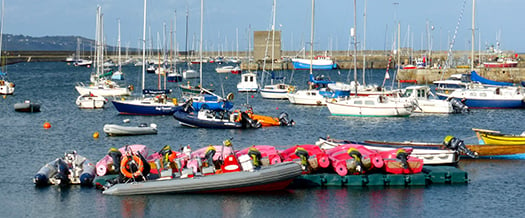
Space is so constrained that a floating dinghy park has to be used to store the smaller craft. Photo: W M Nixon
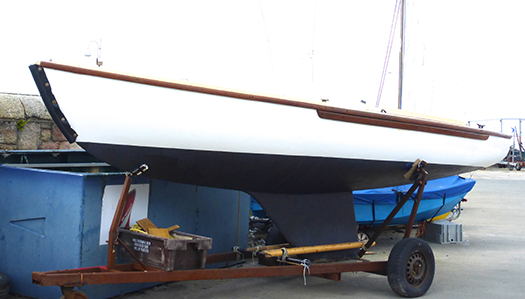
Thanks to the special INSS fendering devised by Arthur Rumball, this 35-year-old Squib has survived many seasons of tough teaching in good order. Photo: W M Nixon
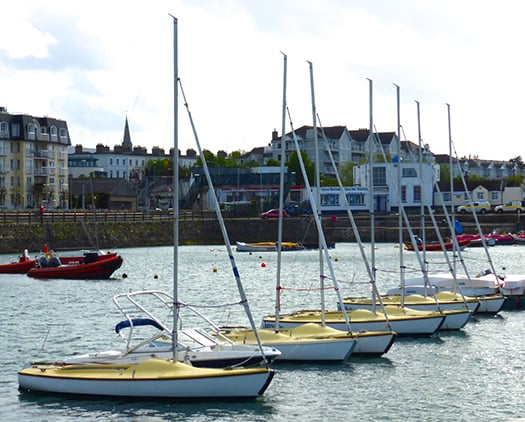
To economise on space, the Squibs berthed here, with the INSS building in the background, are double-moored. Photo: W M Nixon
Of which more anon, for this bare outline gives only a hint of the INSS's complex programme. The Rumball theme is that you have to keep operations and facilities flexible to cope with fluctuating demand, for at the height of the season the school is operating a fleet of 200 boats ranging from kayaks through sailing dinghies of increasing size, then on into keelboats of which some well-fendered Squibs are the workhorses while 1720s provide the glamour input, and finally at the top of the tree there's the Reflex 38 Lynx, bought from Galway this past winter, and becoming part of a programme headed by Alistair's son Kenneth – a Silver Youth Medallist in the 420 – who is now a fully-qualified offshore racing pro teacher, but also races the 1720s while being main operations director of a school which has five full–time employees, but in all has sixty staff at the height of the season.
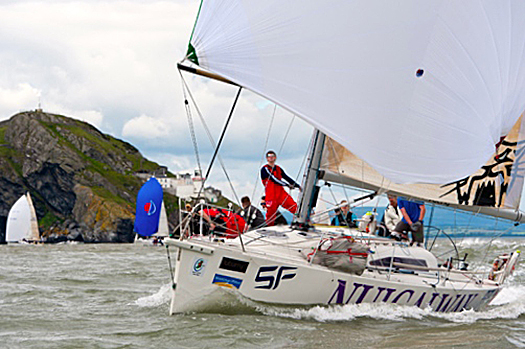
The latest addition to the INSS fleet is the Reflex 38 Lynx, seen here racing for NUI Galway during the Round Ireland. In 2015, Lynx has already scored a second overall in ISORA racing skippered by Kenneth Rumball.
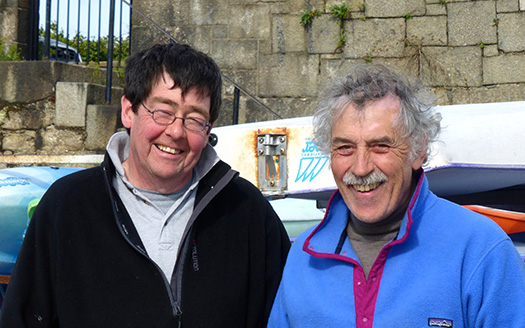
Brothers in business – seen here with his brother Alistair, Arthur Rumball (left) runs the often very busy INSS boat maintenance facility. Photo: W M Nixon
As to shoreside facilities, each summer they set up an additional seasonal summer base to the west of the West Pier with top-of the-line Portakabins at Salthill to provide facilities for those sailing dinghies and kayaks, and in addition the INSS have their own boat-maintenance unit under Arthur Rumball beside the boatyard in the Coal Harbour.
So an impressive amount of things have happened since 1978, the best of them surely being that Alistair persuaded Muriel, a country girl from one of the most beautiful parts of County Carlow, to marry him. For Muriel is a teacher by profession, and adept at being the peace-maker who smooths the waters after Alistair has been making waves, which even now still seems to be just about all the time.
That said, he gives the impression of having so many chips on his shoulder about the perceived opposition to his ventures by those in authority that you begin to think it might be just a bit of an act, for underneath it all he has a heart of gold, yet with the spirit of a lion who will fight the good fight to defend his territory and the interests of his family, friends, trainees and businesses.
The quality of the man was well revealed when the economic recession struck. At the height of the boom years, the Irish National Sailing School had a throughput of more than 2,500 people per month coming new to sailing, and it had become a vibrant and trendy part of the recreational fabric of good-time Dublin. Then around 2008, the economy went into free-fall. But the INSS survived both by making severe cutbacks in everything, and utilising another string in Alistair's bow.
Because of his ready enthusiasm to undertake just about everything and anything to do with boats, back in 1982 he'd looked after some waterborne scenes with classic small craft for the Channel 4 TV comedy-drama series The Irish RM, starring Peter Bowles and Bryan Murray, which went out between 1983 and 1985. It was grand at the time, but thirty years down the line it now seems to have a dose and more of the Paddywhackery about it. However, that was neither here nor there for Alistair Rumball in 1982, for it gave him a lucrative little sideline, and over the years since he has been the man to go to if you want to set up boats and sailing ship scenes in the Irish movie-making business.
So it's ironic, when we remember that Malahide was where the rather mouldy old Vikings of Dublin made their last base after their city had been captured by the Normans in 1171, that it should be a Malahide boy who has emerged as the behind-the-scenes captain of ships for the filming of the blockbuster series Vikings.

When you've spent most of your working life teaching people to sail, tutoring Thespian Viking crewmen on a Wicklow lake is just an ordinary part of another day at the office.
It has all been happening for some years now up in the Wicklow mountains and out on the Wicklow lakes, which have passed themselves off very well as Norwegian fjords, yet can double quite effectively as the coastal and riverside scenery of the many places where the Norwegian Vikings wreaked mayhem.
Who knows, but maybe with the passage of time the epic Vikings series will come to be seen as the epitome of Scandiwhackery, but for now, it certainly does the business . For as the Irish economy fell off a cliff, Alistair Rumball soared aloft in creating, managing, and manoeuvring a very authentic and substantial Viking longship flotilla which has provided a proper Tinseltown income to make all things possible, while helping underwrite the future of the Irish National Sailing School.
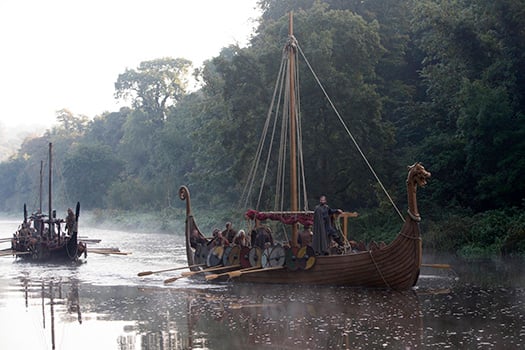
Lough Dan in County Wicklow - where Erskine Childers first sailed around 1890 – has proved remarkably versatile in providing backgrounds for the Vikings which could either be Norway itself, or else the shores of places they are raiding
But it's extraordinarily demanding and time-consuming work, even if he has a staff of 150 specialists up in the Wicklow hills, and after a year or two it became clear that he was trying to do too much. So four years ago his son Kenneth, who is now 27 and was at the time working as an accountant, moved in to take over the direction of the sailing school, and as the recession has started to recede – last year they had monthly numbers pushing back towards the 2,000 mark - Kenneth's energetic and all-encompassing input is seeing the school increasing the scale of its operations, particularly in what might be called the post-graduate side with the development of 1720s at top race level. Now the acquisition of Lynx has developed things further - she has already made what was a rather hasty debut in the first ISORA of the year, but despite being only minutes out of the box, they placed second overall, and that only by six minutes.
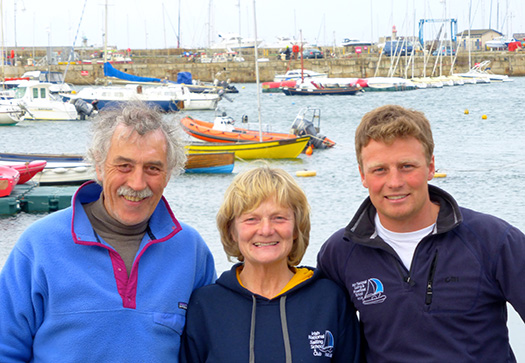
Alistair, Muriel and Kenneth Rumball. Photo: W M Nixon
This placing of racing as a natural part of the INSS syllabus has in turn led to the need for an officially-constituted club to comply with race entry requirements. But in reality the INSS has had a genuine club atmosphere for years, indeed it has more of a truly club-like atmosphere than many a historically-constituted old yacht club. So it was only a formality to bring the Irish National Sailing Club into being in January 201, but it's for real, here's a pic of the Committee of the new club meeting in the old Tom Walsh building on Monday, and if you want to join, it will cost you the outrageous sum of €10.
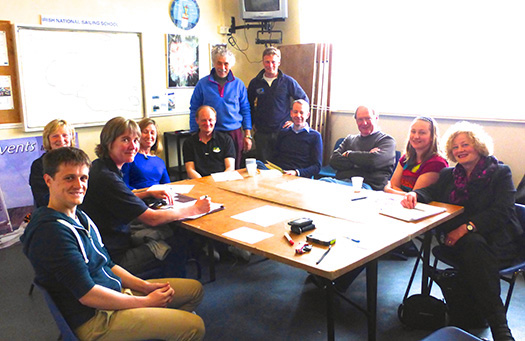
The committee and school management of the newly-formed Irish National Sailing Club are (left to right) Glyn Williams (foreground), Muriel Rumball, Joan Sheffield, Caroline Herron, Robin Jones, Alistair Rumball, Kenneth Rumball, Garrett O'Malley, Dermot Igoe, Heather Blay and Mary Beck. Photo: W M Nixon
As to how Alistair Rumball views the impending possible re-structuring of Dun Laoghaire as a cruise liner port, with inevitable limitations on the amount of sailing which can take place within the harbour, he is both an idealist and a realist.
Like many of us, he dearly wishes that this splendid granite creation could be seen as a cherished part of our heritage, not as something to be used to generate income to turn a crude profit or even just to pay its own maintenance costs. Rather, we'd ideally like to see it treated as a national asset to provide vital recreational space for everyone afloat and ashore.
But Alistair Rumball senses that the government's determination to use just about everything in public ownership to generate income will win the day, and he is already being realistic about what the regular if summer-emphasised arrival of cruise liners will mean.
In fact, he may even derive a certain sardonic satisfaction from seeing the Dun Laoghaire sailing establishment having to contemplate accepting conditions with which his school has complied ever since he began operating it.
"People should realise" he asserts, "that there are already two clearly-define shipping channels in Dun Laoghaire Harbour. One is from the harbour entrance to St Michael's Wharf, which will simply be retained if the cruise liners come. The other, much less widely known, is supposed to be from the harbour entrance to the berth at the Band Stand on the East Pier. Even at present, you are not meant to operate under sail in either of those channels, but an awful lot of boats do so."
"However, as we are a commercial operation, we have a strict policy of complying with regulations and carrying out our sail training and teaching operations in the western part of the harbour, clear of the main channel. So a cruise liner should not affect our in-harbour activities, while our larger craft going out into the bay will have to comply with shipping regulations in the entrance like everyone else".
Whatever happens, we may be sure that the Irish National Sailing School and the Irish National Sailing Club - and their splendid founder - will continue to be a thorn in the side of those who take themselves too seriously and have an inflated idea of their own importance. But if you've never been in a boat before and know nobody in sailing, yet feel a growing enthusiasm to go sailing in Dun Laoghaire, you now know where to go to experience the real thing.
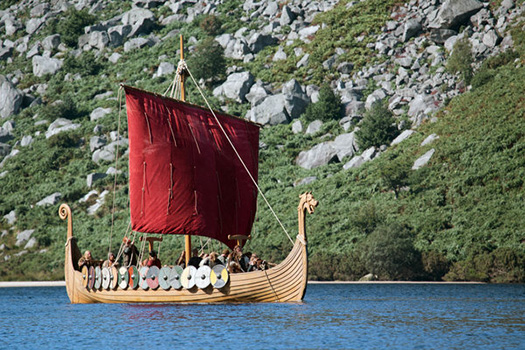
The other side of the INSS show – a Viking ship looking good on Lough Dan
Tonight's Fireball dinghy racing in Dublin Bay, under the burgee of DBSC was cancelled due to a combination of factors - natural and man-made writes Cormac Bradley
The advent of the cruise liner season saw another mega-sized vessel anchored in the race course area of Scotsman's Bay. The inability of such vessels to enter Dun Laoghaire's harbour means that passengers are ferried ashore and "back to base" by a combbination of smaller boats and the cruise liner's own lifeboats. This heightened traffic meant that racing inside the harbour was not a possibility. Hence the man-made intervention!
Mother Nature "pitched in" with a stiff westerly that generated whitecaps for most of the day on Dublin Bay and while there was evidence of this dropping in strength as boats were being rigged, a decision to "blow" the evening was taken.
This forthcoming weekend sees the first of our summer regattas, The Open Championships, being sailed out of Skerries, further up the East Coast from Dublin Bay. Breeze, as usual for this location, is forecast. Numbers are a little low with 4 days to go. Thus far it looks like it will be a substantially DL fleet contesting the event. So to the readership of this column (of which there seen to be many), if you have a Fireball, we'd love to see you on the water!
#dlharbour – The 1083–foot Royal Princess Cruise Liner that anchored in Scotsman's Bay was welcomed at Dun Laoghaire Harbour on schedule this morning, just after 6am. It is the first cruise ship of the season to arrive at Dun Laoghaire and had sailed overnight from Cork Harbour into the Bay. It will remain off Dun Laoghaire Harbour all day, departing at 6pm.
No sooner had the 217–foot high Royal Princess dropped anchor approximately one kilometre east of Dun Laoghaire's East Pier lighhouse than the ship began disembarking some of its 5,000 passengers and crew by tender at 0630 hours.
Just before 7am the first two orange coloured tenders reached the harbour mouth escorted by a RIB flying a yellow flag.
A welcome programme for the Royal Princess will be staged in the seaside town today aimed at increasing visitor interest in Dun Laoghaire, a Dublin suburb located 13km (8miles) south-east of the City Centre.
2015 is set to be the most successful cruise season for Dun Laoghaire, with an expected 100,000 passengers and crew expected to arrive into the Harbour over the next five months. A total of 21 calls will be made to Dun Laoghaire Harbour, with many of the ships involved bringing in more than 5,000 passengers and crew. The Royal Princess is a brand new next generation vessel and was launched in 2013.
This morning's Dun Laoghaire visit follows yesterday's one day stop-over of the MSC Splendida into Dublin Port, the biggest ship ever to visit the city centre.
#dlharbourcruise – Dun Laoghaire Cruise Stakeholder Group has launched its 2015 cruise–liner season. 2015 is set to be the most successful cruise season for Dun Laoghaire, with an expected 100,000 passengers and crew expected to arrive into the Harbour over the next five months. A total of 21 calls will be made to Dun Laoghaire Harbour, with many of the ships involved bringing in more than 5,000 passengers and crew.
The first cruise visit of the season will take place next Tuesday, 12th May with the arrival of the Royal Princess.
The third generation cruise ship will be on its maiden voyage, and will carry over 5,000 crew and passengers. Other ships that will take in Dun Laoghaire on their maiden voyages will be:
· Splendida (21st May)
· Celebrity Silhouette (14th June)
· Star Legend (26th June)
· Britannia (14th July)
· Mein Schiff 4 (18th September)
Ahead of the calls, the Dun Laoghaire Cruise Stakeholder Group has put in place a welcome programme which will run for each cruise call. The welcome programme will comprise of:
Entertainment:
A welcome event will take place from 1pm to 3pm on each day of a cruise visit in the Lexicon Gardens. This event will feature traditional Irish dancing and music by local traditional Irish band, Celtic Hearts. This event will also be open to the public.
Ambassadors:
A team of eight local volunteers will greet each cruise arrival. The multi-lingual volunteers will be armed with local knowledge to help the cruise guests with any queries they might have. The ambassadors will also be dotted throughout the town, and will be easily identifiable in bright green jackets. The ambassadors will inform the passengers of local sights activities, and will also highlight the availability of free Wifi in the town.
Transport:
On arrival, cruise passengers will be transported by four 16-seater Mercedes mini-coaches from the harbour to the welcome event in the Lexicon Gardens. Courtesy shuttle buses will provide continuous transport services throughout the day, every day the cruise is in the harbour. The shuttle bus pick-up location will be signposted and easily identifiable for cruise crew and passengers.
Dun Laoghaire Stakeholder Group is comprised Dun Laoghaire Harbour Company, Dun Laoghaire Rathdown County Council and the local BID Company.
Speaking ahead of the event, Chairperson of Dun Laoghaire Harbour Company, Eithne Scott Lennon said: "We are delighted to be welcoming cruise visits in such numbers to Dun Laoghaire over the coming months.
"The forthcoming cruise season will give us a small insight into the potential which the cruise business has for Dun Laoghaire and the greater hinterland. The Harbour Company has been working collectively with the Council and local businesses to ensure that visitors get a taste of the local area through our welcome programme. Increased cruise visitors should provide a welcome boost to the local economy.
"This cruise season offers a wonderful opportunity to showcase what is available in the area for visitors, and I hope that the wider community will join in the welcome events and entertainment. While it's important to impress the cruise visitors, I also believe that more local families and people interested in ships will also come out to Dun Laoghaire and enjoy the impressive sight of these ships in our harbour. Apart from the multi-story third generation cruise ships, there will also be a selection of smaller and intriguing ships that will come right into the Harbour.
"Everyone can join in the entertainment that is being organised, and I would advise people to log onto our website or follow us on social media to get the latest updates on visits and activities," added Ms Scott Lennon.






























